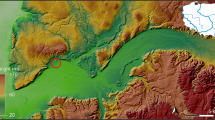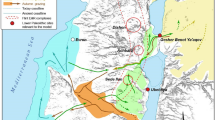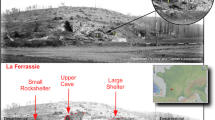Abstract
Dhambalin, a sandstone rock shelter, was discovered in autumn 2007. The unique site holds polychrome paintings including the first sheep paintings in Somali archaeology. There is an extraordinary originality in the paintings, particularly those of the sheep and goats. There are unusual quality images and styles of humpless cows of which some are headless. The fauna depicted include antelopes, dogs, giraffes, snakes and a turtle, some of which are associated with human figures wearing what appear to be headgears and holding bow and arrows in hunting scenes. Relative dating is possible perhaps through the superimposition of various styles of paintings. Also the site shares some similarities with the Neolithic or protohistoric Arabian–Ethiopian Style in the Horn of Africa. Hence, there is a need for a multidisciplinary approach to the ritual landscapes, religion and identity in the Horn of Africa. With its richness of fauna, including unambiguous depictions of sheep and various styles of depiction of bovine, the new site of Dhambalin will no doubt play a major role in shedding light on pastoral cultures and pre-historic symbolism in the rock art of the Horn of Africa.
Résumé
En Automne 2007, Dhambalin un abri à base de pierre de sable fut découvert. Ce site unique en son genre posséde des peintures polychromes qui incluent les premieres peintures de mountons de l’archéologie Somalienne. On trouve une originalité extraordinaire dans ces peintures, en particulier dans celles des moutons et des chèvres. Il y a une qualite d’image inhabituelle, et des styles des vaches sans bosse dont certaines n’ont pas de tête. La faune illustrée décrit des antilopes, des chiens, des giraffes, des serpents et une tortue, aux quels sont associés des corps humains; des corps qui sembleraient porter quelquechose sur la tête et tendre l’arc avec des flèches dans une scène de chasse. Il est possible de donner une date relative à travers la superposition des divers styles de peintures. En plus, le site partage quelques similarites avec le style Néolitique ou le style protohistorique de l’Ethiopie Arabique de la Corne d’Afrique. Par consequent, il y a un besoin d’une approche à disciplines variées concernant l’espace des rituels, de la religion et de l’identite de la Corne d’Afrique. La richesse de la faune qui comprend sans ambiguité des images de moutons, et de plusieurs styles d’images de bovins, ainsi que le nouveau site du Dhambalin, joueront sans aucun doute un rôle majeur dans la compréhension des cultures nomades et du symbole pré-historique de l’art du rocher dans la Corne d’Afrique.










Similar content being viewed by others
References
Andah, B. W. (1995). Studying African societies in cultural context. In P. R. Schmidt, & T. C. Patterson (Eds.), Making alternative histories: the practice of archaeology and history in non-western setting. New Mexico: School of American Research Press.
Bouakaze-Khan, D. (2002). L’art rupestre de la Corne de l’Afrique. Etude globale dans son contexte archéologique et anthropologique. Modèle d’interprétation. Un-published thesis, University of Paris 1-Panthéon-Sorbonne, Paris.
Brandt, S. A. (1986). The Upper Pleistocene and early Holocene prehistory of the Horn of Africa. African Archaeological Review, 4, 41–82.
Brandt, S. A., Brook, G. A., & Gresham, T. H. (1984). Quarternary paleoenvironments and prehistoric human occupation of Northern Somalia. In T. Labahn (Ed.), Proceedings of the second international congress of Somali Studies, Vol. II (pp. 7–22). Hamburg: Helmut Buske.
Brandt, S. A., & Carder, N. (1987). Pastoral rock art in the Horn of Africa: making sense of udder chaos. World Archaeology, 19(2), 194–213.
Breuil, H. (1934). Peintures rupestres préhistoriques de Harar. L’Anthropologie, 44, 473.
Clark, J. D. (1954). The prehistoric cultures of the Horn of Africa. Cambridge: Cambridge University Press.
Clark, J. D. (1972). The prehistoric cultures of the Horn of Africa. New York: Octagon, (reprint and new preface).
Červiček, P. (1971). Rock paintings of Laga Oda (Ethiopia). Paideuma, 21, 47–60.
Červiček, P. (1979). Some African affinities of Arabian rock art. Rassegna di studi ethiopici, XXVII, 5–12.
Graziosi, P. (1964). New discoveries of Rock paintings in Ethiopia. Part I and Part II. Antiquity, 38, 91–98 and 187–194.
Gutherz, X., Cros, J.-P., & Lesur, J. (2003). The discovery of new rock paintings in the Horn of Africa: the rockshelters of Las Geel, Republic of Somaliland. Journal of African Archaeology, 1(2), 227–236.
Hassan, F. A. (1985). Radiocarbon chronology of neolithic and predynastic sites in upper Egypt and the Delta. African Archaeological Review, 3, 95–116.
Hassan, F. A. (1998). The earliest goddess of Egypt. In L. Goodison, & C. Morris (Eds.), Ancient goddesses: the myth and the evidence. London: British Museum.
Hodder, I. (1982). Symbols in action. Cambridge: Cambridge University Press.
Hunt, J. A. (1951). A general survey of Somaliland Protectorate. Crown Agents: London.
Jönsson, S. (1983). Archaeological research cooperation between Somalia and Sweden. Stockholm: Civiltryck.
Joussaume, R. (1981). L’Art Rupestre de l’Ethiopie. In C. Roubet, H. J. Hugot, & G. Souville (Eds.), Préhistoire Africaine: Mélanges offerts au doyen Lionel Balout (pp. 159–175). Paris: ADPF.
Joussaume, R. (Ed.). (1995). Tiya – L’Éthiopie des Mégalithes. Du biface à l’art rupestre dans la Corne de l’Afrique. Mémorie XI. Ministère des Affaires Étrangères, Ministère de la Coopération, Ambassade de France en Èthiopie, UNESCO, UPR 311 du CNRS.
Mire, S. (2007a). Preserving knowledge, not objects: a Somali perspective on heritage management and archaeological research. African Archaeological Review, 24, 49–71.
Mire, S. (2007b). The Future of Somaliland’s archaeological resources. Unpublished report presented to the Ministry of Planning and to the President of Somaliland, H. E. Daahir Riyaale Kaahin.
Pallister, J. W. (1963). Notes on the geomorphology of the Northern Region of Somali Republic. The Geographical Journal, 129(2), 184–187.
Ucko, P. J., & Rosenfeld, A. (1967). Grottkonst. Stockholm: Bonniers.
Watrin, L., Saad, K., & Honoré, M. (2008). The headless beasts of Wadi Sûra II Shelter in the Western Gilf el Kebir: new data on Prehistoric mythologies from the Egyptian Sahara. A paper presented at the Tenth International Congress of Egyptologists. University of the Aegean Rhodes, 22–29 May 2008.
Acknowledgements
I am eternally grateful to the two inhabitants of Beenyo who walked in to my office in Hargeysa on the 21st of Oct, 2007, and for being so persistent I go the Dhambalin shelter near their settlement at Beenyo. I would like to thank H. E. Abdirizaaq Waabari Rooble, Minister of Tourism and Culture, Somaliland for providing funding for the survey trip of Dhambalin. I would like to thank also Mohamed Abdi Ali, my archaeological survey assistance great enthusiasm for the work, and my excellent driver at the time, Adan Haybe. I thank Prof. Fekri A. Hassan, Dr. Aloisia De Trafford and Johan Franzén for useful comments on a draft of this article. I would also like to thank Enrico Crema for assistance with the graphics and Eunice Mabika for the French translation of the article abstract. I also thank Owen Cooney help with the French abstract translation. Last but not least, I thank Ugaso Kahin Bulhan, my indefatigable champion.
Author information
Authors and Affiliations
Corresponding author
Rights and permissions
About this article
Cite this article
Mire, S. The Discovery of Dhambalin Rock Art Site, Somaliland. Afr Archaeol Rev 25, 153–168 (2008). https://doi.org/10.1007/s10437-008-9032-2
Published:
Issue Date:
DOI: https://doi.org/10.1007/s10437-008-9032-2




